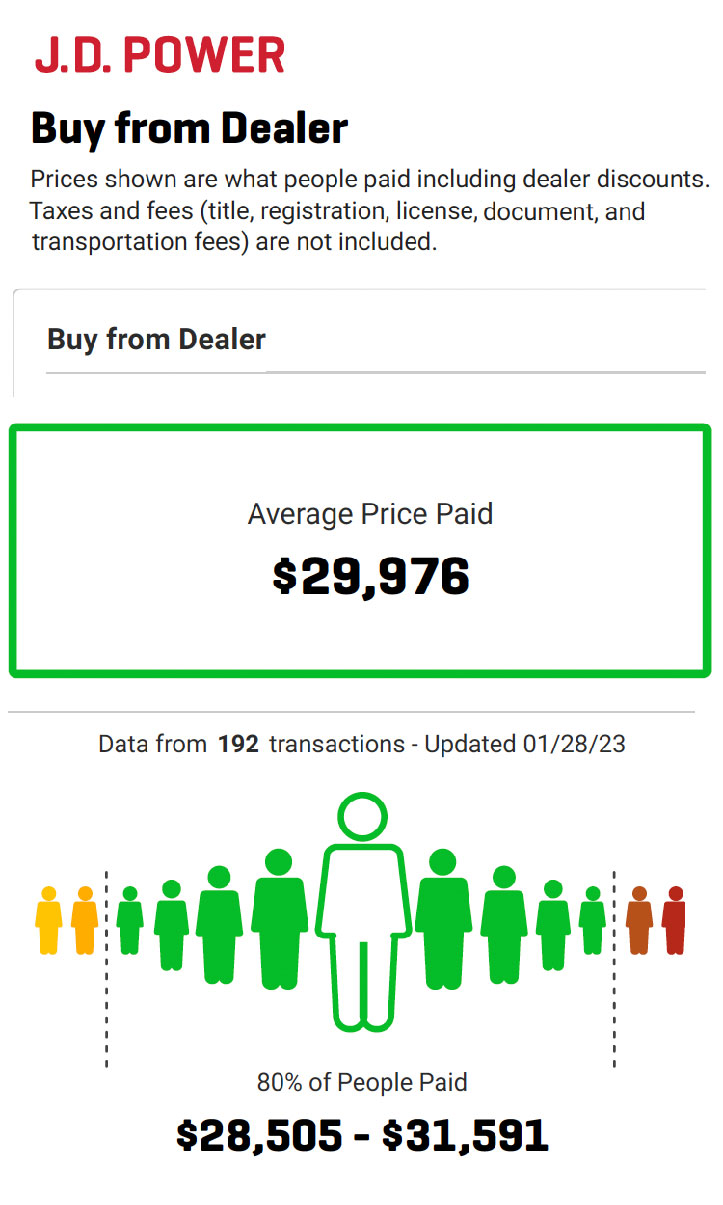What I would do today
to get a fair valuation
of my total-loss vehicle
if I had not yet agreed
to a valuation amount.
If I had not yet agreed
to a valuation amount
for my total-loss vehicle,
then, first, I would try to negotiate
a fair valuation of my toal-loss vehicle.
I would attack and reject the valuation
in the automobile insurance company’s
CCC market valuation report.
I would try to persuade
the automobile insurance company
to value my total-loss vehicle
at its J.D. Power Buy from Dealer price.
I would argue
that my total-loss vehicle’s
J.D. Power Buy from Dealer price
is a fair, reputable, and unbiased calculation
of my total-loss vehicle’s
actual cash value.
what_I_would_do_todayChapter
Your total-loss vehicle’s
actual cash value
is the amount of money
including sales tax
for which you
can reasonably be expected
to replace your total-loss vehicle
with a vehicle
that is substantially similar
to your total-loss vehicle.
The J.D. Power online calculator
calculates the average price
that vehicles substantially similar
to your total-loss vehicle
sold for recently
at local automobile dealerships.
The J.D. Power Buy from Dealer price
for your total-loss vehicle
plus sales tax is a fair,
unbiased, and accurate calculation
of your total-loss vehicle’s
actual cash value.
If your total-loss claim
is a first-party total-loss claim,
then your automobile insurance policy
likely promises
that your automobile insurance company
will value your total-loss vehicle
at its actual cash value.
If your total-loss claim
is a third-party total-loss claim,
then the insurance regulations of your state
may require
the automobile insurance company
that you’re dealing with
to value your total-loss vehicle
at its actual cash value.
What does actual cash value mean?
How do you calculate it?
Actual cash value
is insurance-industry jargon.
Your total-loss vehicle’s actual cash value
is the amount of money including sales tax
for which you the claimant
can reasonably be expected
to replace your total-loss vehicle
with a vehicle that is substantially similar
to your total-loss vehicle.
Substantially similar means:
same make, same model,
same model year, same trim level,
same major options, similar mileage,
and same or better condition.
Hence, actual cash value
does not mean enough money
to purchase a brand new vehicle
of the same make, same model,
same trim level, same major options,
zero mileage, and perfect condition.
In the definition of actual cash value,
the phrase “can reasonably be expected”
implies that the cost to you
to replace your total-loss vehicle
is uncertain.
How do you calculate an uncertain value?

For example,
if I hand you a fair, six-sided die
and I ask you what value you will get
if you roll that die one time,
you don’t know.
The outcome is uncertain.
You could roll a 1.
You could roll a 2.
You could roll a 3.
You could roll a 4.
You could roll a 5.
You could roll a 6.
Psychologically, you might be tempted
to guess.
If you’re an optimist, you might say,
“Oh, I would expect to roll a six—
or at least a five.”
Or, if you’re an pessimist, you might say,
“Oh, I’d probably roll just a two—
or maybe even a one.”
To calculate an expected value,
practitioners of statistics, finance,
law, and business do not guess.
They use a different methodology.
They calculate what is known
in statistics, finance, law, and business
as an expected value.
To calculate the expected value
of an event, you calculate
the probability-weighted average
of the possible outcomes.
In many situations, this calculation
is much simpler than it sounds.
For example, I might ask you:
if you roll an unbiased six-sided die
one time, what is the expected value?
You can calculate that.
If you roll an unbiased six-sided die
one time, there are six possible outcomes.

The six possible outcomes
are 1, 2, 3, 4, 5, and 6.
The probability of each
of these six possbible outcomes
is the same: one in six or ⅙.
To find the expected value
of one roll
of one unbiased, six-sided die,
we multiply the probability
of each possible outcome
times that outcome;
then we sum the six products:
Expected value
= ⅙·1 + ⅙·2 + ⅙·3 + ⅙·4 + ⅙·5 + ⅙·6
= 1/6 + 2/6 + 3/6 + 4/6 + 5/6 + 6/6
= 21/6
= 3.5
The expected value of one roll
of one unbiased, six-sided die
is 3.5
even though, in this example,
that is not a possible outcome.
When possible outcomes all have
the same probability,
then, to get the expected value
of a single event,
you can simply add up
all the possible outcomes
and divide the sum
by the number of outcomes.
To use our same example:
Expected value
= (1 + 2 + 3 + 4 + 5 + 6)/6
= 21/6
= 3.5
Here again, the expected value is simply
the probability-weighted average outcome.
Given this standard procedure
for finding an expected value,
the fairest and ideal way
for an independent valuation corporation
to find the expected value
of your total-loss vehicle
would be to:
-
Gather all the retail prices
for which vehicles substantially similar
to your total-loss vehicle
sold recently at automobile dealerships
in your local market area. -
Sum all those retail prices.
-
Divide the sum
by the number of sales.
The expected value
or actual cash value
of your total-loss vehicle
would be the average
of all those retail sale prices
plus the local sales tax.
While this would be the ideal way
to calculate the actual cash value
of your total-loss vehicle,
ordinarily, it does not work in practice.
Why?
Substantially similar means
same make, same model,
same model year, same trim level,
same major options, similar mileage,
and same or better condition.
Given the large variety of trim levels,
major options, mileages, and conditions
of used vehicles;
few, if any, vehicles
that are substantially similar
to your total-loss vehicle
may have been sold recently
at automobile dealerships
in your local market area.
While the ideal valuation methodology
is not feasible in practice;
J.D. Power comes pretty close.
To calculate the value of a used vehicle,
the J.D. Power valuation calculator
at www.jdpower.com/cars/manufacturers
uses all available data from a large number
of recent sales of similar vehicles
at local automobile dealerships.
From this data, J.D. Power selects vehicles
of the same make, same model,
same model year, and same trim level
as the valuation vehicle.
The J.D. Power calculator takes into account
how the prices of similar vehicles vary
depending on options and mileage.
From this data, the calculator calculates
the average price paid
of a vehicle that is substantially similar
to your total-loss vehicle.

J.D. Power presents its calculations
as a probability distribution.
J.D. Power tells you the range of prices
that 80% of the prices fall into it.
J.D. Power tells you
the probability-weighted average
of those prices.
The average price paid
is the vehicle’s expected value
or expected buy-from-dealer price.
To use the language of the law of many states,
the J.D. Power valuation calculator
calculates the amount of money
for which you can reasonably be expected
to replace your total-loss vehicle
with a vehicle
that is substantially identical
to your total-loss vehicle.
That is, the J.D. Power valuation calculator
calculates your total-loss vehicle’s
actual cash value.
Perhaps of greatest importance to you,
the J.D. Power valuation calculator
is unbiased.
Both buyers and sellers of used vehicles
rely on J.D. Power’s valuations.
J.D. Power’s success as a business
depends on its valuations
being fair to both buyers and sellers
of used vehicles.
Hence, J.D. Power has
a strong financial motive
to be fair
to both buyers and sellers of used vehicles.
To put J.D. Power’s business
and business practices
into courtroom language,
you might say that J.D. Power
has motive, means, and opportunity
to produce valuations that are
fair to buyers of used vehicles,
fair to sellers of used vehicles,
fair to total-loss claimants,
and fair
to automobile insurance companies.
The laws of a few states require
automobile insurance companies
to value total-loss vehicles
at those vehicles’
“fair market values.”
Fair market value is defined as
“the price at which a given property
would change hands
between a willing buyer
and a willing seller,
neither being under any compulsion
to buy or to sell
and both having reasonable knowledge
of relevant facts.”
Because so many buyers and sellers
of used vehicles
rely on J.D. Power for fair valuations,
J.D. Power, in practice,
often becomes the source of choice
for fair market values
of used vehicles and total-loss vehicles.
If you live in one of the states that require
automobile insurance companies
to value total-loss vehicles
at their fair market value,
you can propose
to the automobile insurance company
that they use
the J.D. Power Buy from Dealer price
as your total-loss vehicle’s
fair market value.
Your total-loss vehicle’s
actual cash value
and fair market value
are the same amount of money—
the J.D. Power Buy from Dealer price
plus sales tax.
Remember: No matter what
automobile insurance company reps say
to try to confuse you,
your total-loss vehicle’s
actual cash value
is an average of prices
of all substantially similar vehicles
sold recently at automobile dealerships
in your local market
plus sales tax.
Your total-loss vehicle’s
actual cash value is not
the lowest price
for which a similar vehicle sold.
Your total-loss vehicle’s
actual cash value is not
the lowest price
for which a similar vehicle is for sale.
Your total-loss vehicle’s
actual cash value is not
the lowest amount of money
that the laws of your state
allow the automobile insurance company
to offer you.
“Jerry, why must you
keep harping
on the sales tax?
“Don’t the automobile insurance companies
know that they’re supposed to include
sales tax in the vehicle’s valuation amount?”
Oh, they know it all right!
But that doesn’t necessarily mean
that the automobile insurance company
will include the sales tax
in your settlement check
unless you make sure that they do.
An automobile insurance company
can save itself a big hunk of dough
if it repeatedly “forgets”
to include the sales tax
in its settlements
of total-loss automobile insurance claims.
One automobile insurance company
recently agreed to pay total-loss claimants
$788,220 after it got nabbed
screwing those total-loss claimants
out of the sales-tax portions
of the valuations of their total-loss vehicles.
actual_cash_value_is_an_expected_valueChapter
What is the best way to think
the valuation of your total-loss vehicle
in a CCC market valuation report?
Most likely, the valuation amount
in a CCC market valuation report
is the lowest offer allowed by law.
To maximize their company’s profits,
the automobile insurance company
that you are dealing with
would like to settle
your total-loss claim
for as little money as possible.
To settle your total-loss claim
for as little money as possible,
the automobile insurance company
would like to offer you
as little money
as they can get away with
in their initial valuation offer
for your total-loss vehicle.
Is there a lower limit
to how little money
the automobile insurance commpany
that you are dealing with
can offer you
in their initial valuation offer?
In many states, yes.
In many states,
to set a lower limit
on initial valuation offers,
insurance regulations
identify half a dozen or so sources
that an automobile insurance company
may use as the source
of its initial valuation offer.
The regulations say
that the automobile insurance company’s
initial valuation offer cannot be lower
than the lowest of the valuation amounts
from these sources.
Often, in many states,
the permissible valuation source
that reliably produces
the lowest valuation amount
is CCC Information Services
a.k.a. CCC Intelligent Solutions.
As far as I have been able to find out,
CCC produces valuations
only for automobile insurance companies.
A valuation services vendor
that produces valuations
only for automobile insurance companies
has a strong financial motive
to produce valuations
that undervalue total-loss vehicles.
To produce its valuations,
CCC uses
a proprietary computerized database
and proprietary software.
A proprietary computerized database
means that only CCC
knows what data is in its database.
Proprietary software
means that only CCC
knows what rules and algorithms
are programmed into its software.
A valuation services vendor
that uses a proprietary database
and proprietary software
has the means
to produce valuations
that undervalue total-loss vehicles.
When such a valuation services vendor
uses their proprietary database
and proprietary software to value
a total-loss claimant’s
total-loss vehicle,
that database and software likely gives
the valuation services vendor
many opportunities
to undervalue
the claimant’s total-loss vehicle.
In sum,
when an automobile insurance company
hires a valuation services vendor
that produces valuations
only for automobile insurance companies
and that valuation services vendor
uses a proprietary database
and uses proprietary software
to value your total-loss vehicle,
then that valuation services vendor
has motive, means, and opportunity
to undervalue your total-loss vehicle.
In some states, the law says
that an automobile insurance company
“may settle” a total-loss claim
on the basis of a valuation
that it got
from one of the permissible sources.
“May settle” does not mean
that the automobile insurance company
has the right or the power
to impose a lowball settlement on you.
“May settle” means
that the automobile insurance company
may enter into settlement negotiations
with you on the basis
of the lowball valuation
that they got
from a valuation services vendor
that produces valuations
only for automobile insurance companies.
It’s up to you to exercise your rights.
It’s up to you to fight back.
insurer_s_offer_is_lowest_offer_allowed_by_lawChapter
To persuade
the automobile insurance company
to value my total-loss vehicle
at its J.D. Power Buy from Dealer price,
I would write a letter
to the automobile insurance company.
In the letter that I would write
to the automobile insurance company:
-
I would find fault
with the valuation methodology
that the automobile insurance company’s
valuation-services vendor
used to produce their valuation
of my total-loss vehicle.I might argue that
the automobile insurance company’s
valuation offer
is a flawed, lowball valuation opinion
produced
by a valuation services vendor
that produces valuation opinions
only for automobile insurance companies. -
I would reject
the automobile insurance company’s
valuation offer. -
I would propose a fair valuation
of my total-loss vehicle.I would propose
that the automobile insurance company
value my total-loss vehicle
at my total-loss vehicle’s
J.D. Power Buy from Dealer price. -
I would argue
for the fairness and legitimacy
of the valuation that I propose.I would argue
that the J.D. Power Buy from Dealer price
for my total-loss vehicle
is a fair and unbiased calculation
of my total-loss vehicle’s
actual cash value.
Some parts of my letter would be different
depending on whether my total-loss claim
was a first-party claim or a third-party claim.
If you want to write such a letter,
then, depending on your personality
and on your situation,
you may prefer to write
a polite letter
to the automobile insurance company,
or you may prefer to write
a more muscular letter
to the automobile insurance company.
Let’s first look at the sort of letter
that I would write
to the automobile insurance company
if I wanted to write a polite letter.
Then, let’s look at the sort of letter
that I would write
if I wanted to write a more muscular letter.
I hope that these examples
of what I might write
will help you think through and figure out
what you might want to say
in your letter
to the automobile insurance company
that you’re dealing with.
In case you want to use
what I would write
as a starting point for your letter,
when the time comes,
I will offer you .docx versions
of my letters.
I will offer you letters
that I might write
for a first-party claim.
I will offer you letters
that I might write
for a third-party claim.
I will offer you suggestions
on your preparation of your letter.
to_persuade_write_a_letterChapter
To make what I would do today
easy to follow, let’s work with
a make-believe insurance company,
a make-believe total-loss vehicle,
a make-believe total-loss claim,
and a make-believe
valuation-services vendor.
To walk you through
what I would do today
to get a fair valuation
of my total-loss vehicle
if I had not yet settled my claim,
let’s work with a make-believe example.
Let’s pretend
that the automobile insurance company
is ABC Automobile Insurance Company.
Let’s pretend
that my total‑loss vehicle
is a 2019 Jeep Cherokee Overland,
VIN number 1C4PJMJX2KD249619.
At the time of the total-loss event,
my total-loss vehicle
had 35,082 miles on its odometer.
Let’s pretend
that, at the time of the total-loss event,
my total‑loss vehicle
was in good condition.
It had no accidents reported
in its CarFax vehicle history.
Let’s pretend
that ABC Automobile Insurance Company
paid ZZZ Valuation Services
to concoct a market valuation report
for my total‑loss vehicle.
Let’s pretend
that the ZZZ market valuation report
substantially undervalued
my total‑loss vehicle.
Let’s pretend
that ZZZ’s market valuation report
is chock full of omissions, errors,
and misrepresentations.
Let’s pretend that,
to value my total-loss vehicle,
ZZZ used a dodgy proprietary database
and dodgy proprietary computer software.
Let’s pretend
that ABC’s advertising slogan is
“Peace of mind is as easy as ABC.”
Nota Bene:
ABC Automobile Insurance Company,
ZZZ Valuation Services,
both companies’ employees,
and all actions attributed to them
in this work of art are entirely fictitious.
No identification with actual companies,
actions, events, or persons (living or dead)
is intended or should be inferred.
Any similarity to actual companies,
actions, events, or persons (living or dead)
is purely coincidental (and deeply troubling).
No animals were harmed in the production
of this work of art.
Let_s_work_with_a_make_believe_total_loss_claimChapter
If I wanted to write a polite letter
to the automobile insurance company,
then my letter
and its supporting documents
might look something like this.
If I wanted to write a polite letter
to the automobile insurance company,
then I would write a letter
something like this one.
Or, if the automobile insurance company
was only trying to cheat me
out of a few hundred dollars,
then I likely would rely upon
a letter like this one.
The letter below is still in the draft stage
of development.
Right now,
the docx version of the letter
is developed further
than the version below.
To help me continue my work,
send me a few dollars.
Thank you!
Jerry Marlow
Jerry Marlow
3 Washington Square Village
New York, NY 10012
July 4, 202_
Ms. Jesse Jones
Claim Settlement Representative
ABC Automobile Insurance Company, Inc.
666 Fleece Street, Suite 666
Flimflam City, NY 10000
Re: Claim # 123456
Dear Ms. Jones,
I hope you are having a swell day.
I reviewed the valuation offer
that you sent to me for my total-loss vehicle.
When I searched at automobile dealerships
for vehicles that are substantially similar
to my total-loss vehicle,
none of the substantially similar vehicles
that I found for sale
were for sale for anywhere near
as little money as the ZZZ valuation.
The prices of the substantially similar vehicles
that I found were all very close to $30,000
(sales tax not included).
Their average price seemed to be
right around $30,000 (sales tax not included).
That average price of $30,000 is well above
the amount of money
at which ZZZ Valuation Services
valued my total-loss vehicle.
ZZZ must have made
some sort of data-processing
or computational error.
If my claim were a third-party claim,
then I would add to the letter here
the following sentence.
A settlement based on ZZZ’s valuation amount
certainly is not going to “make me whole”
for the loss of my vehicle
as the law of negligence torts requires.
Accordingly, I do not accept ZZZ’s valuation.
I do not accept ABC’s valuation offer.
I do not propose that,
to value my total-loss vehicle,
we use the price of one
of the substantially similar vehicles
that I found for sale
at an automobile dealership
because none of those vehicles
are for sale at local automobile dealerships.
Instead, I propose that we use
the J.D. Power valuation
of my total-loss vehicle.
If I was able to verify
that my state’s commissioner of insurance
recognizes J.D. Power
as an authorized source of valuations
for total-loss vehicles,
then I would add to the letter here
the following sentence.
I understand that
our state’s commissioner of insurance
recognizes J.D. Power
as an authorized source of valuations
for total-loss vehicles.
If my claim were a first-party claim,
then I would add to the letter here
the following sentence.
In my automobile-insurance-policy contract,
I read that ABC promises,
in the event of a total loss,
to value my total-loss vehicle
at its actual cash value.
The J.D. Power Buy from Dealer price
for my total-loss vehicle appears to be
a fair, accurate, and reasonable calculation
of my total-loss vehicle’s actual cash value.
The J.D. Power Buy from Dealer price
for my total-loss vehicle is $29,976
(sales tax not included).
Hence, I propose that ABC value
my total-loss vehicle at $29,976
(sales tax not included).
To substantiate this valuation, to the email
to which this letter was attached,
I have attached the J.D. Power valuation
for my total-loss vehicle,
the Monroney Label window sticker
for my total-loss vehicle (which I used
to obtain the J.D. Power valuation),
and a printout of the vehicle specs and options
that I used to produce the J.D. Power valuation.
If you and your colleagues agree
to the J.D. Power valuation,
then we can settle my claim
quickly, easily, and amicably.
Please respond to my valuation proposal
via email or letter.
I do not wish to negotiate
the settlement of my claim over the telephone.
I hope that ABC will settle my claim quickly,
reasonably, fairly, and in good faith.
I hope that ABC’s advertising slogan
is sincere, honest and true:
“Peace of mind is as easy as ABC.”
Thank you.
I look forward to hearing from you.
With best personal regards,
Jerry Marlow
To send my letter to ABC,
I would write a brief email like this one.
I would attach my letter
and supporting documents to the email.
To: j.jones@abcautomobileinsurance.com
From: jerrymarlow@jerrymarlow.com
Claim # 123456 response to your valuation offer
Dear Ms. Jones,
I hope you are well.
To this email, I have attached a letter in which I respond to your valuation offer for my total‑loss vehicle.
My letter is the first attachment, Claim_123456_Jerry_Marlow_Response_to_ABC_s_valuation_offer.pdf.
It appears that ZZZ must have made some sort of error or errors in its valuation of my vehicle.
Hence, I cannot agree to ZZZ’s valuation amount.
I propose that we use a different valuation source.
I propose that we use my total‑loss vehicle’s J.D. Power retail valuation of $29,976 (sales tax not included).
To this email, I have also attached: the J.D. Power valuation of my total‑loss vehicle, the Monroney Label window sticker for my total‑loss‑vehicle, and a PDF of the vehicle specs used to produce the J.D. Power valuation of my total‑loss vehicle.
Please respond to my valuation proposal via email or letter.
I do not wish to negotiate the settlement of my claim over the telephone.
I look forward to hearing from you.
With best personal regards,
Jerry Marlow
Attachments:
Claim_123456_Jerry_Marlow_Response_to_ABC_s_valuation_offer.pdf
(The letter you write goes here.)
Total_loss_Vehicle_1C4PJMJX2KD249619_JD_Power_Value_$29,976.pdf
Total_loss_Vehicle_1C4PJMJX2KD249619_Monroney_Label_window_sticker.pdf
Total_loss_Vehicle_1C4PJMJX2KD249619_JD_Power_Specs.pdf
Click on and take a look
at the three supporting documents
attached to the email.
In particular, note that,
to find the average price paid
for vehicles substantially similar
to my total-loss vehicle,
J.D. Power used price data
for 192 similar vehicles.
When you get the J.D. Power valuation
for your total-loss vehicle,
take note of the number of vehicles
from which J.D. Power used price data
to find the average price paid
for vehicles substantially similar
to your total-loss vehicle.
How many comp vehicles did
J.D. Power use
to value your total-loss vehicle?
How many comp vehicles did
the automobile insurance company use
to value your total-loss vehicle?
A large, unbiased data sample produces
a far more reliable result
than does a small, biased data sample.
A polite letter like this one
with email attachments such as these
very well may get you
the same valuation
that a more muscular letter
would get you.
I do not know and cannot predict
how the automobile insurance company
will respond to any letter.
You may wish to discuss with your co-pilot
the pros and cons of going
with the polite approach.
You may wish to prepare
a polite email and attachments
and then ask an attorney
what she or he thinks
of what you have prepared.
Or you may wish to prepare
both a polite letter
and a more muscular letter
and discuss with an attorney
which one you should send.
Whomever you talk to,
in the end,
rely on your own judgement.
This fight for a fair valuation
is a personal-growth opportunity
for you to make big decisions
and to take responsibility
for those big decisions.
“Uh, ummm, uh, Jerry?
“Why write a letter and an email?
“It’d be easier and simpler
just to put everything in the email.
“Don’t you think?”
Easier and simpler, yes.
Keep in mind, however,
that we’re not just negotiating here.
We’re also creating evidence that,
down the line,
you may wish to use in court
or in an arbitration proceeding.
If you find yourself in
either of those situations,
which mental response
would you rather provoke
in your judge or arbitrator?
“Oh Gawd!
Not another badly formatted email to read!”
Or:
“Oh! A thoughtfully formatted letter to read!”
A_polite_letter_might_look_like_thisChapter
If I decided to write a muscular letter
to the automobile insurance company,
then my letter
and its supporting documents
might look something like this.
If I wanted to write a muscular letter
to the automobile insurance company,
then I would write a letter
something like this one.
I would attach my muscular letter
and its supporting documents
to an email which I would send
to the automobile insurance company.
The letter below is still in the draft stage
of development.
Right now,
the docx version of the letter
is developed further
than the version below.
To help me continue my work,
send me a few dollars.
Thank you!
Jerry Marlow
Jerry Marlow
3 Washington Square Village
New York, NY 10012
July 4, 202_
Ms. Jesse Jones
Claim Settlement Representative
ABC Automobile Insurance Company, Inc.
666 Fleece Street, Suite 666
Flimflam City, NY 10000
Re: Claim # 123456
Dear Ms. Jones,
To reach a fair and amicable settlement
of my total‑loss claim,
ABC Automobile Insurance Company
and I first need to agree
on a fair and reasonable valuation
of my total-loss vehicle.
I have received ABC’s valuation offer
for my total‑loss vehicle.
To the best of my understanding,
ABC Automobile Insurance Company
paid ZZZ Valuation Services
to prepare this market valuation report
for my total‑loss vehicle,
a 2019 Jeep Cherokee Overland,
VIN number 1C4PJMJX2KD249619
with mileage of 35,082 miles.
I reviewed the market valuation report
that ZZZ Valuation Services prepared for you.
ZZZ’s market valuation report
inspires neither trust nor confidence.
Were you to choose to write a similar letter,
here, next, you would need to delete
the sentences that I made up
about how ZZZ describes
its market valuation report
and replace those sentences
with similar sentences
that you copy and paste
from the market valuation report
that you received
from the automobile insurance company
that you’re dealing with.
In one section, the document describes itself
as a Market Valuation Report:
“ZZZ Valuation Services has prepared
this Market Valuation Report
for the exclusive use
of ABC Automobile Insurance Company.
“No other person or entity
is entitled to rely
upon this Market Valuation Report
or on any of its contents.
“No other person or entity should rely
upon this Market Valuation Report
or on any of its contents.
“ZZZ is one source of vehicle valuations.
Other sources of valuations are available.”
By thus calling itself a Market Valuation Report,
the document appears to be trying to sound
authoritative and unbiased.
Yet, in another section, the document
describes itself as merely an opinion
or as a reflection of an opinion:
“The ZZZ Market Valuation Report
reflects ZZZ Valuation Services Inc.’s opinion
as to the value of the loss vehicle,
based on information
that ABC Automobile Insurance Company
provided to ZZZ.”
By calling itself merely an opinion
or a reflection of an opinion,
the document sounds like ZZZ
wishes to evade responsibility
for the accuracy of its work product.
I found this switching back and forth
between authoritative language
and evasive language
to be contradictory and confusing.
Nonetheless, from ZZZ’s market valuation report, I understand that:
-
ABC Automobile Insurance Company
provided ZZZ with the description
of my total-loss vehicle
upon which ZZZ based its valuation.ABC’s description
of my total‑loss vehicle
included an abundance of representations
as to my total-loss vehicle’s VIN, mileage,
specs, major options, and condition
at the time of the total-loss event. -
To come up with its valuation
of my total-loss vehicle,
ZZZ relied upon
the completeness and accuracy
of ABC’s representations
in its description
of my total-loss vehicle. -
ZZZ’s valuation is merely an opinion
or a reflection of an opinion. -
Only ABC Automobile Insurance Company
is entitled to rely on ZZZ’s valuation. -
I am not entitled to rely on ZZZ’s valuation.
-
I should not rely on ZZZ’s valuation.
-
I should not rely on any of the contents
of the ZZZ market valuation report.
That is, I should not rely on the accuracy
or veracity of any of the representations
made in the ZZZ market valuation report. -
It would be prudent of me
to obtain valuations from other sources.
I am so advised.
Thank you!
Did ZZZ have motive, means and opportunity
to undervalue my total-loss vehicle?
ZZZ’s description of its valuation methodology
and the valuation methodology itself
caused me to wonder:
Did ZZZ value my total-loss vehicle
honestly, fairly, and accurately?
Or did ZZZ have
motive, means, and opportunity
to significantly undervalue
my total-loss vehicle?
Let’s explore each
of these red-flag factors in turn.
Motive to undervalue: Profit maximization
Profit maximization is the number-one goal
of most, if not all, C corporations.
Quite likely, ZZZ’s management seeks
to maximize ZZZ’s profits.
Hence, quite likely, ZZZ seeks
to produce market valuation reports
that maximize ZZZ’s profits.
What kind of valuation outcomes
would maximize ZZZ’s profits?
To the best of my understanding,
ZZZ sells its vehicle-valuation services
only to automobile insurance companies.
Hence, to maximize its own profits,
ZZZ likely seeks to help its customers—
automobile insurance companies—
maximize their profits.
How can ZZZ help
automobile insurance companies
maximize their profits?
ZZZ can generate market valuation reports
that undervalue
total-loss claimants’ total-loss vehicles.
Every dollar that ZZZ
saves an automobile insurance company
on the valuation
of a claimant’s total-loss vehicle
reduces the automobile insurance company’s
claim-settlement expense by one dollar.
Reductions in claim-settlement expenses
increase an automobile insurance company’s profits dollar for dollar.
Claim-settlement expenses are far and away
an automobile insurance company’s
biggest category of expenses.
Hence, insofar as ABC and ZZZ seek
to maximize their companies’ profits,
ZZZ has a strong financial motive
to produce valuations
that undervalue claimants’ total-loss vehicles
by as much money
as the management of ZZZ
thinks ZZZ can get away with.
Means to undervalue:
A black-box valuation methodology
that lends itself to easy manipulation
of valuation outcomes
As best I was able to figure out
from ZZZ’s market valuation report,
ZZZ uses a proprietary, black‑box,
computerized model to predict the retail price
at which a local automobile dealership
would sell a vehicle
that is substantially similar
to a claimant’s total‑loss vehicle.
To make its prediction,
ZZZ’s black-box model does not use
all the prices
at which substantially similar vehicles
sold recently at local automobile dealerships.
Instead, ZZZ maintains a database of vehicles.
Were you to choose to write a similar letter,
here, next, you would need to delete
the sentences that I made up
about ZZZ’s valuation methodology
and replace those sentences
with the valuation methodology
described in the market valuation report
that you received
from the automobile insurance company
that you’re dealing with.
To predict the retail price
at an automobile dealership
of a vehicle
that is substantially similar
to a claimant’s total-loss vehicle,
ZZZ first selects from its database
a dozen or so somewhat similar vehicles
to use as comp vehicles.
Then, ZZZ makes numerous “adjustments”
to the price of each somewhat similar vehicle
that it selected from its database.
According to the ZZZ market valuation report
that I received for my total-loss vehicle,
ZZZ makes price adjustments
to reflect differences in vehicle attributes—
including mileage, options,
and vehicle condition.
Then ZZZ calculates
“a weighted average of the adjusted values”
of the somewhat similar vehicles
that ZZZ selected from its database.
ZZZ weights its weighted average
based on these factors:
-
Whether ZZZ obtained the data
from advertisements
or from inspection
of the database vehicle. -
Similarity of database vehicle
to total-loss vehicle -
Proximity of the for-sale location
of the database vehicle
to the usual place of garagement
of the total-loss vehicle -
How long ago ZZZ obtained or updated
the information about the database vehicle
This black-box methodology is the means
by which ZZZ can undervalue
a claimant’s total-loss vehicle.
Opportunity to undervalue:
An abundance of opportunities
to reduce the valuation amount
that ZZZ’s valuation methodology produces.
In its valuation methodology,
ZZZ has created for itself
an abundance of opportunities
to misrepresent facts,
bias its selections,
fudge its “adjustments,”
and tilt its weightings—
all in ways that reduce the valuation amount
that its black-box model produces
for a claimant’s total-loss vehicle.
Through intentional “errors and omissions,”
ZZZ can misrepresent
the specifications and options
of a claimant’s total-loss vehicle
in ways that lower
that vehicle’s valuation amount.
Likewise, ZZZ can misrepresent
the specifications and options
of its database vehicles
in ways that lower
a total-loss vehicle’s valuation amount.
To undervalue claimants’ total-loss vehicles,
ZZZ can select from its database
only the somewhat similar vehicles
the prices of which
are at the lower end
of the somewhat-similar-vehicle price range.
ZZZ can include in its database
vehicles that are advertised on the internet
with low click-bait prices—
even though a would-be buyer
cannot actually buy those vehicles
at their low advertised prices.
If ZZZ uses prices of vehicles
that have not yet been sold,
ZZZ may program into its software
to take a deduction
from those vehicles’ list prices
on the questionable assumption
that the actual sales price
of each vehicle
will be less than its list price.
ZZZ can fudge up the vehicle conditions
of its database vehicles
and fudge down the vehicle condition
of a claimant’s total-loss vehicle.
Such double fudging
can reduce a valuation amount significantly.
If I was able to verify
that my state’s laws
limit the mileage differences
between total-loss vehicles
and substantially similar vehicles,
then I would add to the letter here
the following two sentences.
Our state’s laws limit
the mileage differences
between total-loss vehicles
and substantially similar vehicles.
ZZZ can ignore these limitations
and subtract hundreds
or even thousands of dollars
from the value of a claimant’s total-loss vehicle
because ZZZ’s selected database vehicles
have lower mileages.
To produce a low weighted-average valuation,
ZZZ can update information
on low-value database vehicles
so that those low-value vehicles
weigh heavier in its weighted average.
Likewise, ZZZ can inspect
only low-value database vehicles
so that those low-value vehicles
weigh heavier in its weighted average.
These are all simple and obvious ways
in which ZZZ can misrepresent facts,
bias its selections,
fudge its “adjustments,”
and tilt its weightings
to produce low vehicle valuations
for automobile insurance companies.
Clever valuation specialists
and systems developers at ZZZ
may have figured out many more ways
to manipulate their black-box model and its data
to produce low vehicle valuations
for automobile insurance companies.
Did ZZZ have motive, means and opportunity
to undervalue my total-loss vehicle?
A preponderance of evidence
strongly suggests that the answer
to our question is:
“Yes.”
In many states,
the laws that govern
how automobile insurance companies
are required to value total-loss vehicles
and settle total-loss claims
take away a first-party claimant’s right to sue
his or her automobile insurance company
for punitive damages
if his or her automobile insurance company
engages in reprehensible misconduct.
If my claim were a first-party claim
and I lived in a state
that took away my right
to sue my automobile insurance company
for punitive damages,
then I would add to the letter here
the following argument.
Is it fair and realistic of me to suspect
that ZZZ undervalued my total-loss vehicle?
Ordinarily, American consumers presume
that corporations honor contractual obligations
of good faith, honesty, and fair dealings.
Ordinarily, many American consumers
(or their attorneys) know that,
if a corporation breaches
its contractual obligations
of good faith, honesty, and fair dealings
and engages in reprehensible misconduct;
then the consumer can sue the corporation
not only for compensatory damages
but also for punitive damages.
Punitive damages are
on top of compensatory damages.
Punitive damages can be as much as
three times compensatory damages.
Ordinarily, the possibility
of having to pay punitive damages
for engaging in reprehensible misconduct
deters corporations
from engaging in reprehensible misconduct.
Given contractual obligations
of good faith, honesty, and fair dealing
and given the threat of punitive damages
for engaging in reprehensible misconduct,
is it fair and realistic of me to suspect that,
to maximize their company’s profits,
ZZZ might misrepresent facts,
bias selections, fudge “adjustments,”
and/or tilt weightings
to produce low vehicle valuations?
Let’s explore that question.
An automobile insurance policy is a contract
between an automobile insurance company
and the policyholder.
But an automobile insurance policy
is not an ordinary contract.
The regulatory regime
that our state’s legislators
created for automobile insurance companies
that do business in our state
takes away a policyholder’s right
to sue
his or her automobile insurance company
for punitive damages
for engaging in reprehensible misconduct.
Absent the deterrent of punitive damages,
why wouldn’t employees
of automobile insurance companies
and employees
of automobile insurance companies’
valuation services vendors
engage in whatever types of conduct
that they believe will maximize
their companies’ profits?
Also, I am aware that,
in at least one court case,
Milligan v. GEICO Gen. Ins. Co.,
20-3726-cv (2d Cir. Feb. 14, 2022),
an automobile insurance company
and its valuation-services vendor
successfully argued
that the valuation-services vendor
had no contractual obligations
[such as duties of good faith, honesty, and fair dealing]
to the total‑loss claimant because
1) the total‑loss claimant
was not a party to the contract
between the automobile insurance company
and its valuation-services vendor
[lack of privity] and
2) the contract
between the automobile insurance company
and its valuation-services vendor
did not imply that the total‑loss claimant
was a third-party beneficiary of that contract.
At the same time
that a valuation services vendor can argue
that it has no obligation
of good faith, honesty, and fair dealing
to the total-loss claimant,
an automobile insurance company
can argue that it has no responsibility
for the validity of a valuation opinion
that it purchased from another corporation.
Given the free pass
that our state’s legislators have granted
to automobile insurance companies
on punitive damages;
given the free pass
that the law gives
valuation services vendors
on contractual obligations
to a total-loss claimant
of good faith, honesty, and fair dealing;
and given that no one is legally accountable
to the total-loss claimant
for the legitimacy and validity
of a valuation opinion
that an automobile insurance company
buys from a valuation services vendor;
I believe it is both fair and realistic
for me to suspect that,
to maximize their companies’ profits,
ABC or ZZZ or both just might have
misrepresented facts, biased selections,
fudged “adjustments,” or tilted weightings
to produce an unfairly low valuation
for my total-loss vehicle.
ZZZ predicted
that an automobile dealership
would sell a vehicle
that is substantially similar
to my total-loss vehicle
for $24,444 (sales tax not included).
Using the valuation methodology
described above,
ZZZ’s proprietary,
black‑box computerized valuation model
predicted that a vehicle
that is substantially similar
to my total‑loss vehicle
and that is for sale
at a local automobile dealership
will have a retail price of $24,444
(sales tax not included).
How can a total-loss claimant
determine if ZZZ valued
his or her total-loss vehicle
fairly and accurately?
A total-loss claimant has no feasible way
to directly investigate and analyze
ZZZ’s opaque, black-box methodology.
To validate or repudiate
a ZZZ valuation directly,
a total-loss claimant
would have to survey
the entire market
of somewhat similar vehicles.
A total-loss claimant
would have to survey
the marginal difference
that every option on a vehicle
makes to the vehicle’s total value.
A total-loss claimant
would have to survey
the differences in vehicle value
associated with differences
in that vehicle’s mileage.
For every somewhat similar vehicle
in ZZZ’s database,
a total-loss claimant
would have to do due diligence
on every data item.
A total-loss claimant
would have to do due diligence
on every line of computer code
in ZZZ’s valuation software.
A total-loss claimant is unable
to do any of these things—
much less do all of them.
I do not agree with ZZZ’s valuation.
I do not accept ABC’s valuation offer.
Whereas ZZZ had motive, means,
and opportunity
to undervalue my total-loss vehicle,
whereas ZZZ had no legal obligation or duty
to me to produce a fair and honest valuation,
and whereas ABC bears no legal responsibility
for the fairness or honesty
of ZZZ’s valuation of my total-loss vehicle;
I do not agree
to ZZZ’s valuation of my total-loss vehicle.
I do not accept ABC’s valuation offer
of $24,444 (sales tax not included).
Instead, I propose that,
to value my total-loss vehicle,
we use its J.D. Power valuation
of $29,976 (sales tax not included).
J.D. Power is a valuation source
approved by our state’s Commissioner of Insurance.
J.D. Power has no financial motive or incentive
to either undervalue or overvalue
total-loss vehicles.
Both buyers and sellers of used vehicles
rely on J.D. Power’s valuations.
J.D. Power’s success as a business
depends on its valuations
being fair to both buyers and sellers
of used vehicles.
Hence, J.D. Power has
a strong financial motive
to be fair to both buyers and sellers
of used vehicles.
To put J.D. Power’s business
and business practices
into courtroom language,
one might say that J.D. Power
has motive, means, and opportunity
to produce valuations
that are fair to buyers of used vehicles,
fair to sellers of used vehicles,
fair to total-loss claimants,
and fair
to automobile insurance companies.
I obtained and documented
a J.D. Power valuation.
To get the J.D. Power valuation,
I entered my total‑loss vehicle’s mileage
of 35,082 miles
into J.D. Power’s online calculator
at www.jdpower.com/cars/manufacturers.
I entered the vehicle specs and major options
that are on my total‑loss vehicle’s
Monroney Label window sticker.
I entered the zip code
of my total‑loss vehicle’s principal place
of garagement.
J.D. Power’s value calculator reported that,
for 192 recent sales
of similar vehicles
in my local market,
the average selling price was $29,976
(sales tax not included).
The J.D. Power Buy from Dealer price
for my total-loss vehicle
is a fair, accurate, and reasonable calculation
of my total-loss vehicle’s actual cash value.
To substantiate this J.D. Power valuation,
to the email by which I transmitted
this letter to you,
I attached
the J.D. Power valuation
for my total loss vehicle,
the Monroney Label window sticker
for my total loss vehicle
that I used to obtain
the J.D. Power valuation,
and a printout
of the vehicle specs and options
that I used to produce
the J.D. Power valuation.
Whereas the valuation that I propose
is in full, demonstrable, documented,
and verifiable compliance
with our state’s insurance regulations
and with other laws of our state,
I trust that you and your colleagues
will agree that the $29,976 valuation
(sales tax not included)
that I propose is fair to all.
If you and your colleagues agree
to the J.D. Power valuation,
then we can settle my claim
quickly, easily, and amicably.
Please respond to my valuation proposal
via email or letter.
I do not wish to negotiate
the settlement of my claim over the telephone.
Thank you.
I look forward to hearing from you.
With best personal regards,
Jerry Marlow
In_a_first_party_claim_a_muscular_letter_might_look_like_thisChapter
Whaddaya think, my friend?
Did my muscular letter
do anything for you?
As you read it, did you smile?
Did you utter the F word?
Did you get goosebumps?
Did your skin tingle?
I love when my writing
makes people’s skin tingle!
“Well, Jerry, I liked the attitude of the letter.
“Nothing mealy mouthed about it.
“But the letter is so long!
“As I kept reading and reading,
I got frightened that the letter
was never e v e r r r r
going to end!
“My skin did not tingle,
but the hairs
on the back of my neck
did stand up.
“Why write such a long letter?
“Why go into so many issues
in so much detail?
“I’ve never, ever, read
a letter that long before—
much less wrote one!”
Whaddaya_think_my_friendChapter
We write a long letter
because we write
with the eyes
of a judge or arbitrator
in mind.
If you include in your letter
all the arguments
and all the evidence
that you would want
to present in court
if you sue,
then you have almost no work
left to do to prepare to sue
if you need to sue.
If you vet your letter
with an attorney in your county,
then you should be well prepared
to respond to any questions
that your judge
or court arbitrator might ask
if you sue.
If you vet your letter
with an attorney in your county,
then you should be well prepared
to respond to any issues
that the attorney
for the automobile insurance company
might raise
if you sue.
We write a long letter
mostly because we write our letter
for more than one audience.
The obvious audience is the folks
at the automobile insurance company.
But they may not be
your most important audience.
If you end up
going through an appraisal process,
then you can give a copy of your letter
and its supporting documents
to the appraiser that you hire.
The appraiser whom you hire
can show your letter
and its supporting documents
to the third appraiser.
Your letter
and its supporting documents
may win the third appraiser over
to a valuation favorable to you.
If you end up suing
the automobile insurance company
or you end up going through
an arbitration procedure,
then your letter
and its supporting documents
will be important pieces of evidence.
Most likely, your judge or arbitrator,
will read your letter
and look at its supporting documents.
Hence, your letter is an opportunity
to communicate important points—
and your reasonableness—
to your judge or arbitrator.
If you sue
the automobile insurance company
in a small-claims lawsuit,
the judge or small-claims court arbitrator
will not expect you
to cite the laws
on which you base your claims.
In fact, your judge
or small-claims court arbitrator
may not want you to cite any laws.
“Why do you say that?”
Most likely, your judge or arbitrator
will be an attorney.
Attorneys can be a little prickly
about us unwashed ignoramuses
telling them
what the law says.
Hence, if you end up
in a small-claims lawsuit
and your judge
or small-claims court arbitrator
is not acquainted
with your state’s laws and regulations
that govern
how automobile insurance companies
are required to value total‑loss vehicles
and settle total‑loss claims,
then your letter—
your letter offered into evidence—
is an opportunity to, as they say,
“refresh your judge
or small-claims court arbitrator’s memory.”
Also, in a small-claims lawsuit,
the judge or small-claims court arbitrator
will not expect you
to present your argument in writing.
Hence, in a small-claims lawsuit,
your long letter can accomplish
much of what a legal brief
would accomplish
in a large-claims lawsuit.
In your letter,
you can argue your side of the story
in an organized, thorough,
and persuasive way.
If you sue
the automobile insurance company
in a large-claims lawsuit, then, most likely,
the judge who hears your case
will expect you to submit a legal brief.
A legal brief is a written document
in which you state your claims,
make your argument for each claim,
and cite the laws and court cases
that support your argument
for each of your claims.
If you include your citations and arguments
in your letter, then, if and when need be,
you can translate your letter
into a legal brief;
or you can ask your legal coach
to help you translate your letter
into a legal brief;
or you can hire a freelance paralegal
to translate your letter
into a legal brief.
And, my friend,
there’s another angle
to factor into your thinking.
When the folks
at the automobile insurance company
read your long letter,
not only will they read it
through their own eyes;
they’ll also read it
through the eyes of a judge or arbitrator.
If, through the eyes
of a judge or arbitrator,
they see conspiracy to commit fraud
written all over
their collusion
with their valuation services vendor
to misrepresent facts
and undervalue your total-loss vehicle,
then the folks
at the automobile insurance company
may utter the F word.
Every time they discover more evidence
that you are not a gullible,
bumbling, trusting fool;
they may utter the F word
again and again.
Every time they utter the F word,
that may mean
another thousand dollars
added to the valuation
of your total‑loss vehicle.
Let’s get’em to say the F word
as many times as we can.
And so, for these reasons,
my friend,
I favor a long letter.
At least, that’s what I’d do.
“I see.
“Our strategy is
to get the con artists
at the automobile insurance company
to cuss up a blue streak!”
Better to make them curse you
than to let them,
behind your back,
smirk and giggle
about what a fool you are.
So, are you good to go
with a long letter?
“Maybe. We’ll see.”
You are so hard to please!
If you’re still feeling uneasy, my friend,
then maybe you’re a little discombobulated
because you did not expect
the letter
to be so long?
A basic principle of warfare says:
Strategically, do the unexpected.
Tactically, hit your adversary
where he is weakest.
The automobile insurance company
doesn’t expect a long letter either.
Most likely, where
the automobile insurance company
is weakest
is its market valuation report.
If the automobile insurance company
and its valuation services vendor
are trying to screw you
out of thousands of dollars,
then you’re at war.
Or, at least I would be.
I say:
Do the unexpected!
Write a long, powerful, comprehensive letter.
I say:
Hit your adversary where he is weakest.
Attack the automobile insurance company’s
market valuation report.
How ’bout you?
Whose side are you on?
Yours?
Or the automobile insurance company’s?
“Okay! Okay!
“I got your point.”
Good!
Looking at you,
I see you also got
a funny look on your face.
What else is eating at you?
“Well, since you asked …”
We_write_with_the_eyes_of_a_judge_or_arbitrator_in_mindChapter
“Jerry, shouldn’t I ask
the automobile insurance company
to correct the mistakes
in their market valuation report
and re-value my vehicle
with the correct information?”
“In your muscular letter to ABC,
Jerry, I noticed that you did
something real different
from what you and Maria
did in your letters
to the insurance companies.
“In your and Maria’s letters, you told
the automobile insurance companies
about the omissions, errors, misrepresentations,
and defective calculations
in their market valuation reports.
“You and Maria asked
the automobile insurance companies
to correct their mistakes
and to re‑value your vehicles
using the correct information.
“Shouldn’t I do that?”
My friend, my dear, innocent friend;
let’s dig into your observation
and into your question.
The CCC valuation opinions
that Maria and I received
made this request:
“Please review the information
in the Vehicle Information Section
to confirm the reported mileage
and to verify
that the information accurately reflects
the options, additional equipment
or other aspects of the loss vehicle
that may impact the value.”
A request like this is a work of genius!
“How so, Jerry?
“Looks innocuous to me.”
That’s part of its genius!
If the valuation opinion
that you received
makes a request like this
and you are insufficiently wary,
then that request
can accomplish many things!
-
The request that
you “review,” “confirm,” and “verify”
can mislead you into believing
that the automobile insurance company’s
valuation services vendor
is trying to come up with
an honest and accurate valuation. -
If you comply with this request,
then you allow
the automobile insurance company
and its valuation services vendor
to shift responsibility
for the accuracy of their description
of your total‑loss vehicle
from them to you! -
If you allow them
to put the onus for accuracy on you,
then you make yourself susceptible
to the notion that,
with correct information,
the valuation services vendor’s
black-box valuation model
will produce a legitimate valuation.Fat chance of that!
-
Which is to say,
if you correct their omissions and errors,
then, by your engagement
with their valuation opinion,
you legitimize the valuation
that results from your corrections. -
Once you start legitimizing their opinion,
it gets psychologically harder and harder
for you to reject the opinion’s valuation.
This cascade of effects
can set aswirl a psychological whirlpool
that will suck you into the scam
that the automobile insurance company
and its valuation services vendor
are running.
Pretty clever, huh?
“Sounds diabolical.”
Uh huh.
“Do you suspect that
the automobile insurance company
and their valuation services vendor
are possessed by the devil?”
I dunno.
Maybe.
To prep for negotiations with them,
you may want to watch
“The Exorcist” again.
You may want to load
your water pistol
with holy water.
“P s s s s s s s s s s s s !”
I’m embarrassed to admit it,
but I allowed myself
to get sucked
into this diabolical whirlpool twice!
Fool that I was,
I pointed out to Travelers
the omissions and errors
in the description of my totaled vehicle
in CCC's market valuation report.
Doing so did not get me a fair valuation.
Bigger fool that I was,
I suggested to Maria
that she point out
to her automobile insurance company
the omissions and errors
in the description of her totaled vehicle
in the CCC market valuation report
that she received.
She did.
Doing so did not get Maria a fair valuation.
I almost fell for this con job a third time.
When I set to work on wasyourcartotaledorstolen.com,
I planned to suggest to you—
to you, my dear friend—
that you find and correct
the omissions and errors
in the description of your total‑loss vehicle
in the valuation report that you received.
I planned to suggest to you
that you ask
the automobile insurance company
to revalue your vehicle
with your corrections.
But then that voice
finally spoke up.
“Uh, which voice was that, Jerry?”
That voice that dwells within each of us—
that voice that—
however long it may take—
finally speaks up
when we’ve been suckered
one time
too many.
That voice said:
“Wait a gol dern minute, here!
“Hold your galloping horses!
“Your horses are headed off a cliff!
“If an automobile insurance company
actually wanted accurate descriptions
of total‑loss vehicles,
then they would train
their claims adjusters
to provide accurate descriptions.
“If an automobile insurance company
and its valuation‑services vendor
actually wanted to know
what options were on total‑loss vehicles,
then they would pull Monroney Labels
on those vehicles.
“If an automobile insurance company
actually wanted to come up
with fair valuations for total-loss vehicles,
then they would use a valuation source
that both buyers and sellers
of used vehicles trust.”
With these epiphanies,
I experienced a cascade
of further realizations:
I was not responsible
for the accuracy
of Travelers’s description
of my vehicle
in their valuation opinion for my vehicle.
They were!
Maria was not responsible
for the accuracy
of her automobile insurance company’s
description of her vehicle
in their valuation opinion for her vehicle.
They were!
You are not responsible
for the misrepresentations and defects
in the automobile insurance company’s valuation opinion.
The automobile insurance company is!
If you try to correct
the automobile insurance company’s
omissions, errors, defects,
and misrepresentations;
and you try to correct
the valuation services vendor’s
omissions, errors, misrepresentations,
and defective calculations;
then you’ll be digging your own grave.
Those omissions, errors,
misrepresentations,
and defective calculations
are your evidence
of the automobile insurance company’s
reprehensible bad‑faith misconduct.
That evidence
of the automobile insurance company’s
reprehensible bad‑faith misconduct
could be your ticket
to winning a lawsuit
or an arbitration proceeding.
Why on earth
would you want to correct
those omissions, errors,
misrepresentations,
and defective calculations?
“Got it, Jerry!”
Shouldn_t_I_ask_the_insurance_company_to_correct_their_mistakesChapter
I would write a brief email to
ABC Automobile Insurance Company.
To the email, I would attach:
-
My muscular letter
-
The J.D. Power valuation
of my total-loss vehicle -
The Monroney Label window sticker
for my total-loss vehicle -
A PDF of the vehicle specs
used to produce
the J.D. Power valuation
To send my muscular letter
and its supporting documents
to the automobile insurance company,
I would write a brief email.
I would attach my muscular letter
and its supporting documents to the email.
My email and its attachments
would look something like this.
To_send_the_muscular_letter_to_ABC_I_write_an_emailChapter
To: j.jones@abcautomobileinsurance.com
From: jerrymarlow@jerrymarlow.com
Claim # 123456 response to your valuation offer
Dear Ms. Jones,
I hope you are having a wonderful day.
To this email, I have attached a letter in which I respond to ABC Automobile Insurance Company’s offer to value my total‑loss vehicle at $24,444 (sales tax not included).
My letter is the first attachment, Claim_123456_Jerry_Marlow_s_response_to_ABC_s_valuation_offer.pdf.
In my letter, I reject ZZZ’s valuation.
I explain in detail why I reject ZZZ’s valuation.
Because ABC’s valuation offer is based on ZZZ’s valuation,
I do not agree to ABC’s valuation offer.
Instead, I propose that, to value my total‑loss vehicle, we use my total‑loss vehicle’s J.D. Power retail valuation of $29,976 (sales tax not included).
To this email, I have also attached: the J.D. Power valuation of my total‑loss vehicle, the Monroney Label window sticker for my total‑loss‑vehicle, and a PDF of the vehicle specs used to produce the J.D. Power valuation of my total‑loss vehicle.
Please respond to my valuation proposal via email or letter.
I do not wish to negotiate the settlement of my claim over the telephone.
I look forward to hearing from you.
With best personal regards,
Jerry Marlow
Attachments:
Claim_123456_Jerry_Marlow_s_response_to_ABC_s_valuation_offer.pdf
(The letter you write goes here.)
Total_loss_Vehicle_1C4PJMJX2KD249619_JD_Power_Value_$29,976.pdf
Total_loss_Vehicle_1C4PJMJX2KD249619_Monroney_Label_window_sticker.pdf
Total_loss_Vehicle_1C4PJMJX2KD249619_JD_Power_Specs.pdf
Think about a letter like mine
and its supporting evidence
from the other side.
Imagine that you work
for an automobile insurance company
as a claims agent.
Imagine that you receive this email,
letter, and supporting documents.
What would you choose to do?
Would you choose to do all the reading,
analysis, and other work necessary
to push back?
Or would you choose to say
what Maria’s claims agent chose to say?
Maria’s claims agent said,
“Okay.
“We can use your valuation.”
To_send_the_muscular_letter_to_ABC_I_write_an_emailChapter
Nota bene
Jerry Marlow is not an attorney. Neither information nor opinions published on this site constitute legal advice. This site is not a lawyer referral service. No attorney‑client or confidential relationship is or will be formed by use of this site. Any attorney listings on this site are paid attorney advertising. In some states, the information on this website may be considered a lawyer referral service.
Terms of use
Jerry Marlow grants human users of wasyourcartotaledorstolen.com permission to use the copyrighted materials on wasyourcartotaledorstolen.com for their personal use free of charge.
The fee to use copyrighted materials on wasyourcartotaledorstolen.com to train artificial intelligence software (AI) is $4 million.
Reproduction of copyrighted materials on wasyourcartotaledorstolen.com for commercial use without the written permission of Jerry Marlow is strictly prohibited.
Jerry Marlow does not grant users permission to reproduce on other websites any of the copyrighted material published on wasyourcartotaledorstolen.com.
Jerry Marlow does not grant users permission to reproduce via audio, video, or any other audiovisual medium any of the copyrighted material published on wasyourcartotaledorstolen.com.
If you wish to use any of the copyrighted material published on wasyourcartotaledorstolen.com in any way for which permission is not explicitly granted, contact Jerry Marlow at jerrymarlow@jerrymarlow.com.










